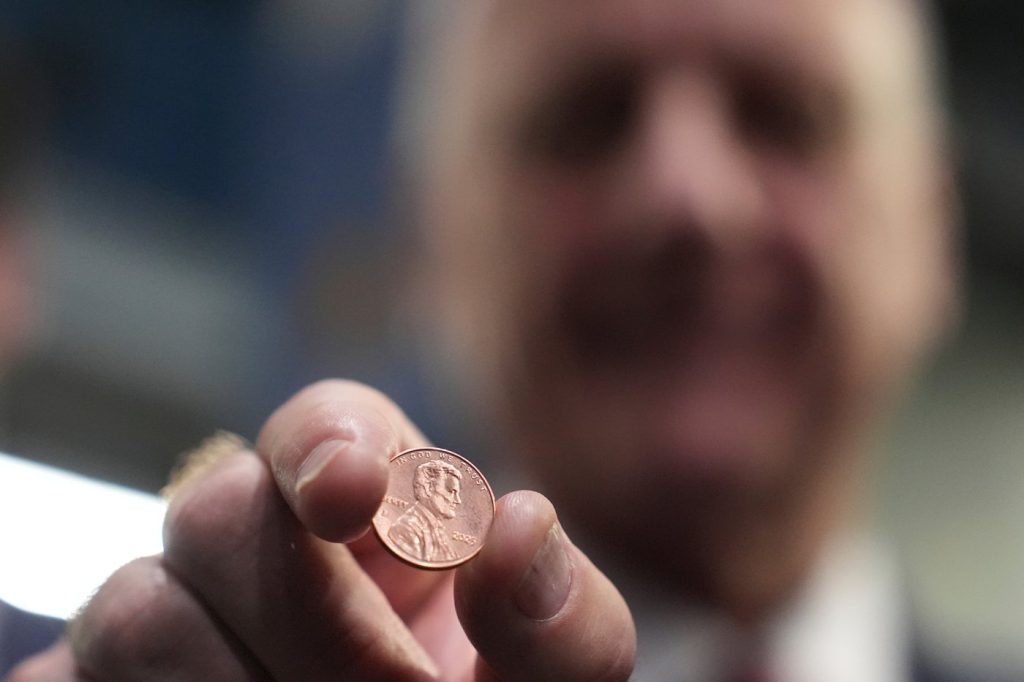PHILADELPHIA (AP) — The United States officially ended production of the penny on Wednesday, November 12, 2025, marking the conclusion of a coin that has been a part of American culture for over 230 years. Once valued for its purchasing power, the penny has lost much of its significance and is considered nearly worthless today.
Since its introduction in 1793, the penny could previously buy items like a biscuit, a candle, or a piece of candy. Presently, most pennies are relegated to jars or junk drawers, and the cost to produce each penny now sits at nearly 4 cents. U.S. Treasurer Brandon Beach, at the U.S. Mint in Philadelphia, expressed the intention to save taxpayers approximately $56 million by ceasing penny production. During the concluding event, Beach pressed a button to produce the last penny, which was subsequently placed on a tray for media display. The last few coins produced were designated for auction.
Despite the cessation of new production, billions of pennies remain in circulation and will still be accepted as legal tender. Beach cited that the last U.S. coin to be discontinued before the penny was the half-cent, which ceased production in 1857. Most penny production had already been halted over the summer, and during the final press, workers at the mint held a poignant moment of silence, eventually culminating in applause and cheers as the last coins were struck.
President Donald Trump had ordered the penny's discontinuation due to rising production costs, expressing concern that the expense was excessive. In an online post made in February, Trump stated, “For far too long the United States has minted pennies which literally cost us more than 2 cents. This is so wasteful!”
Despite its demise, many Americans still maintain a sentimental attachment to the penny, viewing it as a symbol of luck or a collector's item. In anticipation of the production halt, several retailers expressed their concerns, noting the abruptness of the phaseout and the lack of governmental guidance on how to navigate transactions without pennies. Some retailers took creative measures to deal with the forthcoming shortage, including rounding prices to avoid giving change or incentivizing customers with prizes for turning in large amounts of pennies.
Jeff Lenard of the National Association of Convenience Stores noted that while they had been advocating for the penny's elimination for 30 years, they had not anticipated such a sudden conclusion. Proponents of eliminating the coin argue that doing so could lead to cost savings, quicker checkouts, and greater efficiency in transactions. Other countries, such as Canada, have already ceased minting their own pennies, having done so in 2012.
As the production of pennies was phased out, some banks began rationing their supplies, a decision that seemed somewhat ironic given the historical glut of these coins. Over the last century, approximately half of the coins produced at mints in Philadelphia and Denver were pennies. Interestingly, while the penny costs nearly 4 cents to produce, the nickel's production cost is even higher, at nearly 14 cents. Comparatively, the dime costs less than 6 cents, and a quarter runs close to 15 cents to manufacture.
From a historical perspective, collectors and historians regard pennies as significant artifacts, representing American culture and values. Frank Holt, an emeritus professor at the University of Houston who has studied coins, expressed his sorrow about the end of the penny, emphasizing that these coins bear the nation’s mottoes, self-identification, and a reflection of societal ideals and aspirations.












